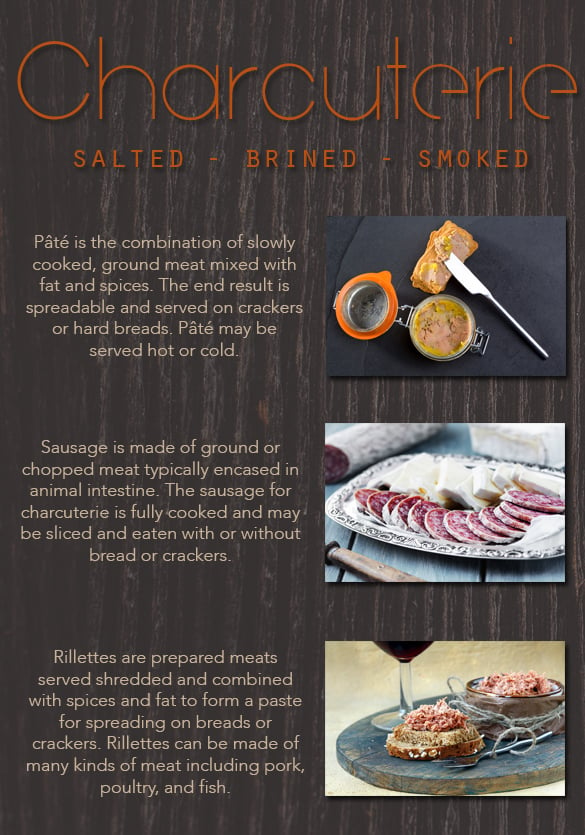
What is Charcuterie?
Small plates and dressed-up appetizers have been a staple on menus for years now, from independent brewhouses and neighborhood bars to trendy tapas spots and family-style restaurants. Avid foodies and casual dinner hosts alike are hungry for the sense of community the shared meal experience provides, especially when those shareables are thoughtfully prepared with quality ingredients that pair good flavors and great presentation. Though it's one of the easiest assemble-and-enjoy appetizer options out there, charcuterie is far from a bare-bones topic.
If you're new to the delightful delicacy of a charcuterie board, we'll brush up on its rich history and modern interpretations and offer some tips on how to make your own version at home.
Definition and Origin of Charcuterie
When talking about charcuterie (pronunciation: shar-coo-tur-ee), it's important to distinguish between the traditional cooking technique and the modern dinner party appetizer we most often associate it with today.
Charcuterie – a French term, pronounced with less enunciation on the second half (more like shar-coo-tree) – originally referred to methods of preparing and preserving meats, extending the shelf life of those products in a time before refrigeration. These may primarily be pork products (think bacon, ham, and sausage), but charcuterie can also include beef, chicken, and other types of meat.
Charcuterie is prepared through various processes, some of which involve many spices and intricate steps, such as chopping, grinding, shaping, and aging. The main idea behind the preparation of charcuterie (French translation: "cooked flesh") is that the meat is fully cooked, and it can be salted, brined, or smoked to prepare it for consumption. Common types of charcuterie include pâté, rillettes, and sausage.

Centuries ago in France, charcuterie was prepared by charcutiers and sold in stores appropriately called charcuteries. Eventually, the concept traveled over from France and the term evolved as it became ingrained in our culture, though its meaning in a professional culinary setting remains the same. To the common foodie, however, it has become synonymous with wood boards piled high with meat, cheese, produce, and dips, leading to a now-thriving culture of meat-and-cheese plates.
Modern Charcuterie Boards
Whether you think of them as "adult Lunchables" or "the most beautiful party platter I've ever put together," charcuterie boards have become increasingly popular. It's no surprise that in the age of hashtags and filters, these picture-perfect plates are making a splash on social media, hailed as everything from a fad for inventive influencers to a form of food-based therapy.
How to Build a Charcuterie Board
Unlike the well-defined world of professional charcuterie, there aren't any rules when it comes to assembling a charcuterie plate. If you choose to enjoy a smorgasbord of meat and cheese at a restaurant or opt to serve one at your next gathering, there is an almost endless list of options to explore. To help you make the most out of your plate, KaTom's resident charcuterie board enthusiast, graphic designer Jessica Scott, shared some tips.
Variety is the spice of life. This old adage holds true for your future charcuterie board, too. Check your local grocery store or food market for packets of meat that offer more than one kind – salami alongside prosciutto, for example – or research which types of cold cuts might appeal to you and try to provide a few different options for a satisfying culinary experience.
Slice the cheese (or don't). Triangular blocks of cheese can make a visual statement, and you can always provide cheese knives so guests can cut off as much as they want. However, cheese cubes or slices may be a more sanitary option and can be easier to fit into your overall presentation. There's no wrong way to incorporate your cheese – just remember to give your guests a few different flavors and textures to enjoy. You can check our guide about different types of cheese to learn more about which ones might appeal to you.
You can never have too many fruits and veggies. There may be a limit to the amount you can actually fit on your board, but incorporating plenty of produce into your display will guarantee your guests have enough to snack on (and provide plenty of options for vegetarian attendees). Plan your board with an abundance of grapes, olives, pickles, and other bite-sized delights in mind. Strawberries, tomatoes, and raspberries can add bright pops of color throughout your board.
Don't forget the bread and crackers. No charcuterie board is complete without a little crunch. Crackers and pita chips make great additions to your board. Not only are they available in different flavors, they can also be used to layer meat and cheese for a satisfying snack. Adding a soft bread alongside your crunchier options will give guests a nice change of pace throughout the evening as well.
Include dips and sauces for extra flavor. Offering dips and sauces such as hummus, honey, jams, and jelly is the perfect way to complement your board. For something with more kick, Dijon mustard can make a great topping. These can be placed in small bowls and ramekins; they also make great anchors for assembling your board, so you can build around them instead of trying to squish your condiments onto the board once you've carefully laid out your meat and produce.
Have fun with your canvas. You can build your charcuterie masterpiece on any attractive board you have or on multiple smaller boards if you have space to display them. Most bread and cheese boards are real or imitation wood, but serving and display boards made of melamine can look like marble, slate, and other types of stone.
Not sure where to start building your charcuterie board? Try out some of Jessica's favorite combinations – lemon hummus, soft rosemary bread, and prosciutto, or peach jam and brie – and see where your culinary experiment takes you.

